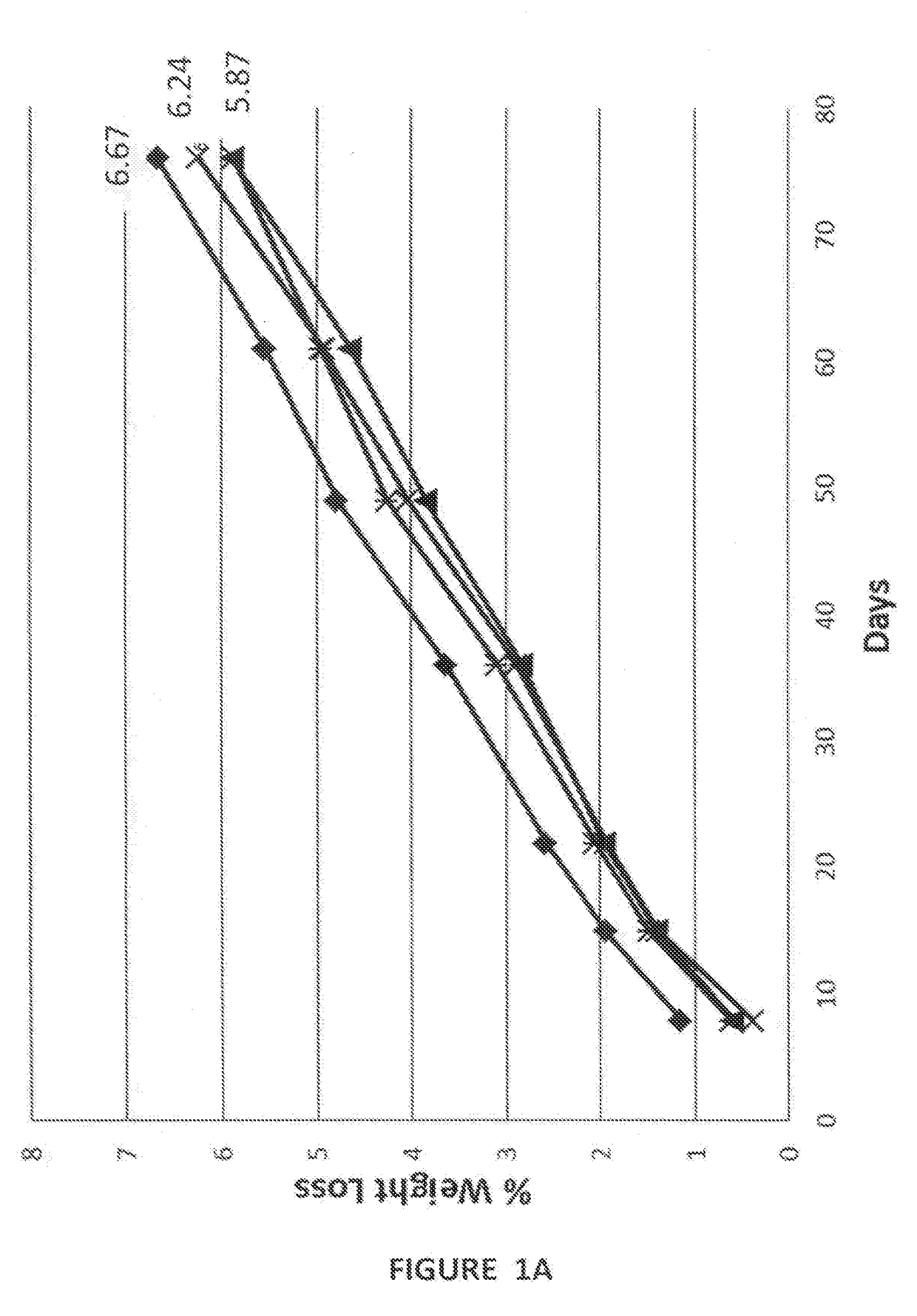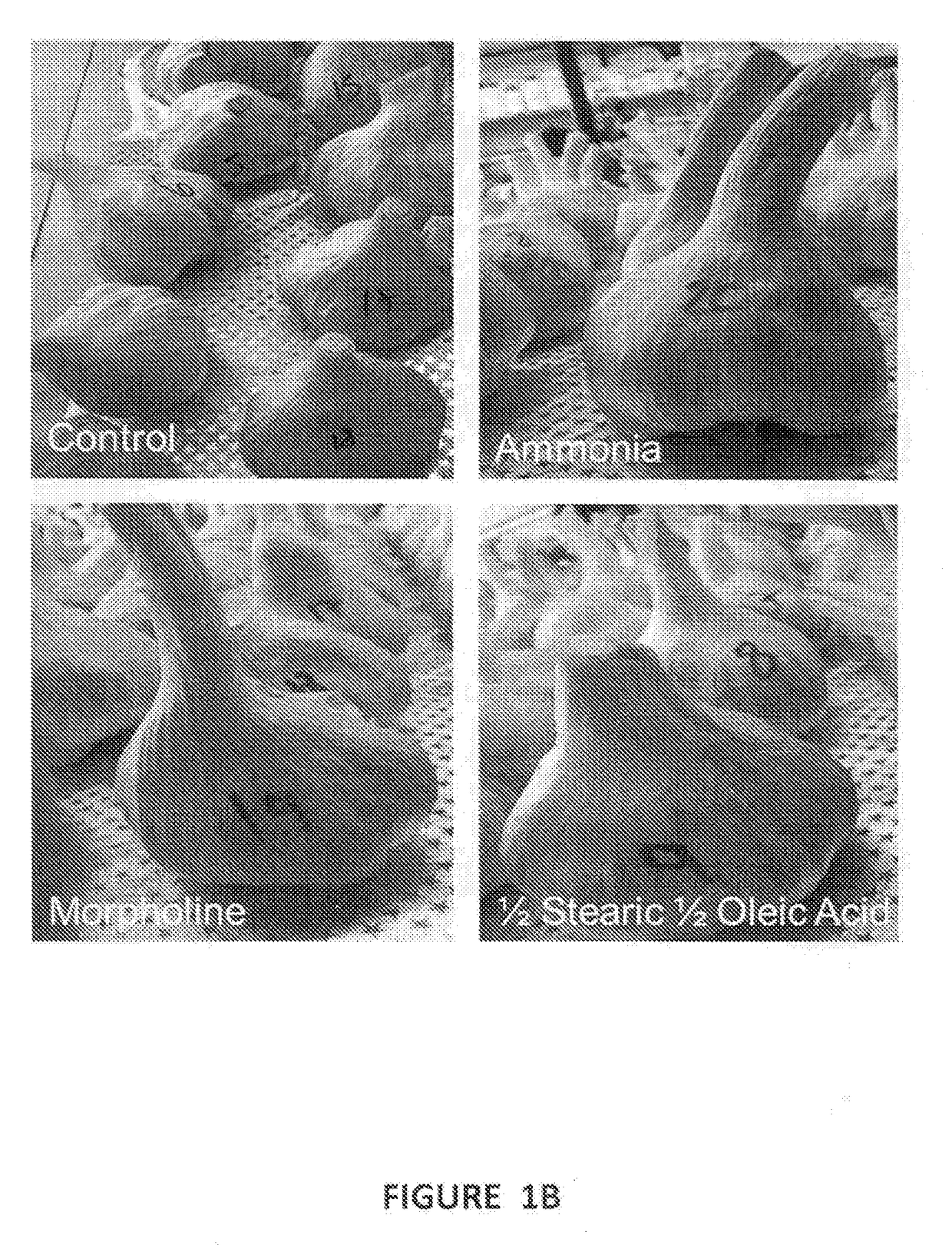Edible morpholine-free coating formulations
a technology of morpholine-free coating and plant, applied in the direction of coatings, wax coatings, alginic acid coatings, etc., can solve the problems of reducing the exchange of respiratory gas, reducing the structural stability of day wax coatings, and sufficiently attenuating the passage of water vapors, so as to reduce the weight and quality of plants, reduce mechanical damage, and reduce postharvest water loss
- Summary
- Abstract
- Description
- Claims
- Application Information
AI Technical Summary
Benefits of technology
Problems solved by technology
Method used
Image
Examples
example 1
Coating of Onions and Garlic
Materials and Methods
[0140]The coating compositions used throughout the experiments of Examples 2-12 are summarized in Tables 1 and 2, below.
TABLE 1Compositions.#Alg*BW*OA*SA*PA*β-sit*Amm*NaOHKOHNa2CO3Mor*12%0.2%1.8%0.2%0.25%22%0.2%1.8%0.2%0.3%32%0.2%0.9%0.9%0.2%0.3%42% 1%1.8%0.2%1.5%52% 2%1.8%0.2% 3%62% 5%1.8%0.2%7.5%72%0.2%1.8%0.3%82% 1%1.8%1.5%92%0.2%1.8%0.2%0.12%102%0.2%1.8%0.2%0.15%112%0.2%1.8%0.2%1.6%122% 1%0.5%0.3%132% 1%1.8%0.2%0.15%142% 1%0.5%0.15%152%0.2%0.9%0.9%0.2%0.15%162%0.2%0.9%0.9%0.2%0.15%172%0.2%0.9%0.45% 0.45% 0.2%0.15%182% 2%1.8%0.2%0.15%192% 2%0.5%0.15%202%1.5%1.8%0.2%0.15%212%1.5%0.5%0.15%222% 1%1.8%0.2%0.3%232%1.3%0.5%0.2%0.15%242% 1%0.33% 0.15%251%0.5%0.0165% 0.0755% The percentages are by weight (% w / w).*Alg—alginate;BW—beeswax;OA—oleic acid;SA—stearic acid;PA—palmitic acid;β-sit—β-sitosterol;Amm—ammonia;Mor—morpholine.
TABLE 2Compositions per ExampleExampleComposition234567891011121++2+++++3+4+5+6+7+8+9+++10++++11+++1...
example 2
Weight Loss—Comparison of Morpholine with Ammonia
[0145]To test the effect of morpholine replacement in the coating formulation with ammonia, control garlic bulbs were left uncoated and the change in their fresh weight was compared with that of garlic bulbs coated with Formulations #1-#3 detailed in Table 1. The bulbs' weight loss was followed for about three months and the data presented in FIG. 1A, shows clearly that coating with either of Formulations #1-#3 resulted in reduced bulbs' weight losses by about 12% compared to the non-coated bulbs. The experiment teaches that 0.25% morpholine (Formulation #1) can be replaced with 0.3% ammonia (Formulation #2), and that 50% of the oleic acid can be replaced with stearic acid (Formulation #3), with little effect on the formulations' efficacy.
[0146]It is therefore concluded that when weight loss reduction is concerned, morpholine and ammonia perform as equivalent alkaline components, and that oleic acid and steric acid perform as equivale...
example 3
Weight Loss—Effect of Wax and Ammonia Content
[0147]To test the effect of different beeswax and ammonia concentrations on coating Formulations' ability to slow down weight loss of coated produce (with or without β-sitosterol), garlic bulbs were left uncoated, or were coated with Formulations #2 and #4-#8 detailed in Table 1 (all with a wax:ammonia 2:3 weight ratio), and the bulbs' weight loss was followed for about three months. The data presented in FIG. 2 teaches that 0.2% beeswax and 0.3% ammonia effectively slow down the bulb's weight loss for up to about 17% compared to uncoated bulbs (Formulations #2 and #7), and that increasing said concentrations to 1% and 1.5%, respectively, necessitates the use of β-sitosterol to retain efficacy (Formulation #4). Further increasing the concentrations of wax and ammonia has a negative effect and in fact increases the bulb's weight loss (Formulations #5, #6 and #8).
[0148]Interpreted together with the experimental data provided in Example 1, i...
PUM
| Property | Measurement | Unit |
|---|---|---|
| melting temperature | aaaaa | aaaaa |
| temperatures | aaaaa | aaaaa |
| melting temperature | aaaaa | aaaaa |
Abstract
Description
Claims
Application Information
 Login to View More
Login to View More - R&D
- Intellectual Property
- Life Sciences
- Materials
- Tech Scout
- Unparalleled Data Quality
- Higher Quality Content
- 60% Fewer Hallucinations
Browse by: Latest US Patents, China's latest patents, Technical Efficacy Thesaurus, Application Domain, Technology Topic, Popular Technical Reports.
© 2025 PatSnap. All rights reserved.Legal|Privacy policy|Modern Slavery Act Transparency Statement|Sitemap|About US| Contact US: help@patsnap.com



